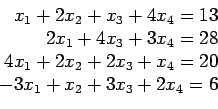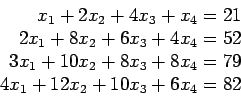Next: Interpolation and Curve Fitting Up: Solving Sets of Equations Previous: Parallel Processing Contents
function X = uptrbk(A,B)
%Input - A is an N x N nonsingular matrix
% - B is an N x 1 matrix
%Output - X is an N x 1 matrix containing the solution to AX=B.
%Initialize X and the temporary storage matrix C
[N N]=size(A);
X=zeros(N,1);
C=zeros(1,N+1);
%Form the augmented matrix: Aug=[A|B]
Aug=[A B];
for p=1:N-1
%Partial pivoting for column p
[Y,j]=max(abs(Aug(p:N,p)));
%Interchange row p and j
C=Aug(p,:);
Aug(p,:)=Aug(j+p-1,:);
Aug(j+p-1,:)=C;
if Aug(p,p)==0
'A was singular. No unique solution'
break
end
%Elimination process for column p
for k=p+1:N
m=Aug(k,p)/Aug(p,p);
Aug(k,p:N+1)=Aug(k,p:N+1)-m*Aug(p,p:N+1);
end
end
X=backsub(Aug(1:N,1:N),Aug(1:N,N+1));
And for back substitution;
function X=backsub(A,B) %Input - A is an n x n upper-triangular nonsingular matrix % - B is an n x 1 matrix %Output - X is the solution to the linear system AX = B %Find the dimension of B and initialize X n=length(B); X=zeros(n,1); X(n)=B(n)/A(n,n); for k=n-1:-1:1 X(k)=(B(k)-A(k,k+1:n)*X(k+1:n))/A(k,k); end

>> A=[1 2 1 4; 2 0 4 3; 4 2 2 1; -3 1 3 2] >> B=[13 28 20 6]' >> uptrbk(A,B)
function [X,Y] = lufact(A,B)
%Input - A is an N x N matrix
% - B is an N x 1 matrix
%Output - X is an N x 1 matrix containing the solution to AX = B.
%Initialize X, Y,the temporary storage matrix C, and the row
% permutation information matrix R
[N,N]=size(A);
X=zeros(N,1);
Y=zeros(N,1);
C=zeros(1,N);
R=1:N;
for p=1:N-1
%Find the pivot row for column p
[max1,j]=max(abs(A(p:N,p)));
%Interchange row p and j
C=A(p,:);
A(p,:)=A(j+p-1,:);
A(j+p-1,:)=C;
d=R(p);
R(p)=R(j+p-1);
R(j+p-1)=d;
if A(p,p)==0
'A is singular. No unique solution'
break
end
%Calculate multiplier and place in subdiagonal portion of A
for k=p+1:N
mult=A(k,p)/A(p,p);
A(k,p) = mult;
A(k,p+1:N)=A(k,p+1:N)-mult*A(p,p+1:N);
end
end
%Solve for Y
Y(1) = B(R(1));
for k=2:N
Y(k)= B(R(k))-A(k,1:k-1)*Y(1:k-1);
end
%Solve for X
X(N)=Y(N)/A(N,N);
for k=N-1:-1:1
X(k)=(Y(k)-A(k,k+1:N)*X(k+1:N))/A(k,k);
end

>> A=[1 2 4 1; 2 8 6 4; 3 10 8 8; 4 12 10 6] >> B=[21 52 79 82]' >> [X,Y]=lufact(A,B)
function [k,X]=jacobi(A,B,P,delta, max1)
% Input - A is an N x N nonsingular matrix
% - B is an N x 1 matrix
% - P is an N x 1 matrix; the initial guess
% - delta is the tolerance for P
% - max1 is the maximum number of iterations
% Output - X is an N x 1 matrix: the jacobi approximation to
% the solution of AX = B
N = length(B);
for k=1:max1
for j=1:N
X(j)=(B(j)-A(j,[1:j-1,j+1:N])*P([1:j-1,j+1:N]))/A(j,j);
end
err=abs(norm(X'-P));
relerr=err/(norm(X)+eps);
P=X';
if (err<delta)|(relerr<delta)
break
end
end
X=X';

>> A=[4 -1 1; 4 -8 1;-2 1 5] >> B=[7 -21 15]' >> P=[1,2,2] >> [k,X]=jacobi(A,B,P,10^-9,20)